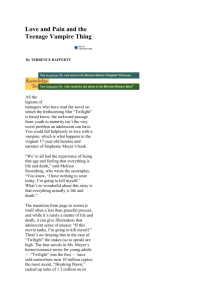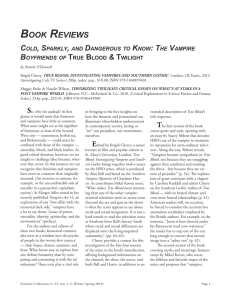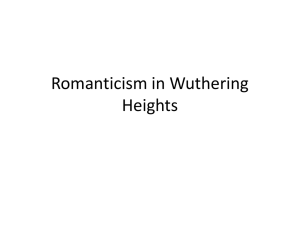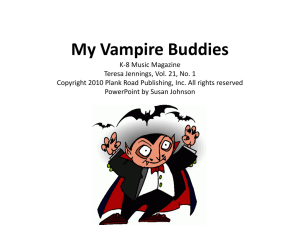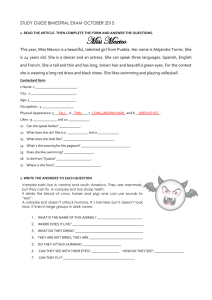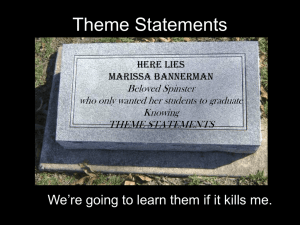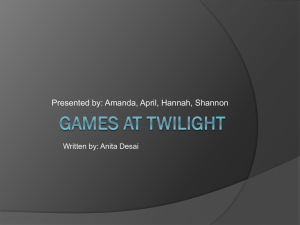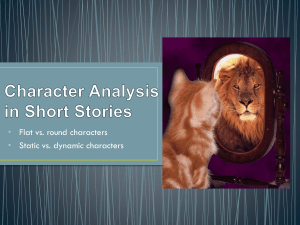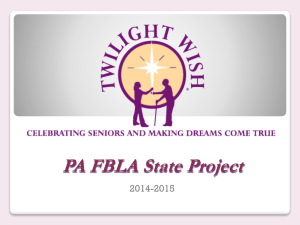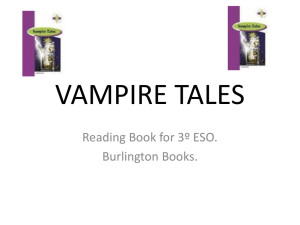Fransen Abigail Fransen Dr. Dickson Core 110 9 November 2012
advertisement
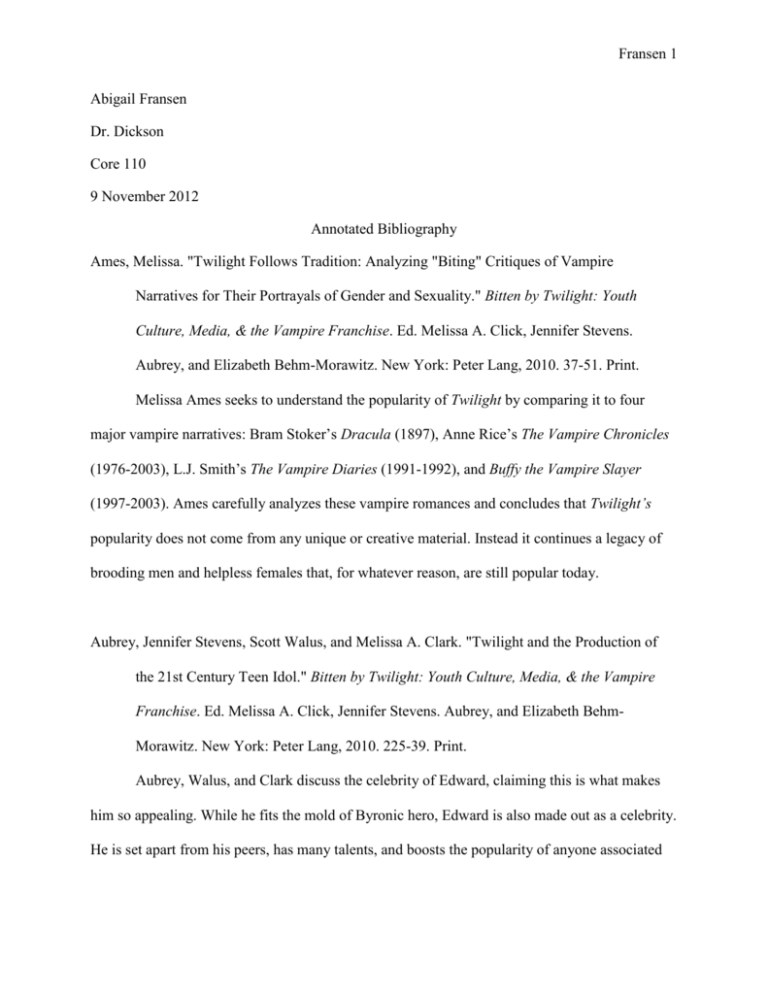
Fransen 1 Abigail Fransen Dr. Dickson Core 110 9 November 2012 Annotated Bibliography Ames, Melissa. "Twilight Follows Tradition: Analyzing "Biting" Critiques of Vampire Narratives for Their Portrayals of Gender and Sexuality." Bitten by Twilight: Youth Culture, Media, & the Vampire Franchise. Ed. Melissa A. Click, Jennifer Stevens. Aubrey, and Elizabeth Behm-Morawitz. New York: Peter Lang, 2010. 37-51. Print. Melissa Ames seeks to understand the popularity of Twilight by comparing it to four major vampire narratives: Bram Stoker’s Dracula (1897), Anne Rice’s The Vampire Chronicles (1976-2003), L.J. Smith’s The Vampire Diaries (1991-1992), and Buffy the Vampire Slayer (1997-2003). Ames carefully analyzes these vampire romances and concludes that Twilight’s popularity does not come from any unique or creative material. Instead it continues a legacy of brooding men and helpless females that, for whatever reason, are still popular today. Aubrey, Jennifer Stevens, Scott Walus, and Melissa A. Clark. "Twilight and the Production of the 21st Century Teen Idol." Bitten by Twilight: Youth Culture, Media, & the Vampire Franchise. Ed. Melissa A. Click, Jennifer Stevens. Aubrey, and Elizabeth BehmMorawitz. New York: Peter Lang, 2010. 225-39. Print. Aubrey, Walus, and Clark discuss the celebrity of Edward, claiming this is what makes him so appealing. While he fits the mold of Byronic hero, Edward is also made out as a celebrity. He is set apart from his peers, has many talents, and boosts the popularity of anyone associated Fransen 2 with him. Like Bella, Twilight fans fantasize “that someday they will be singled out and admired by their idol” (229). Bella’s ability to achieve this dream gives the audience hope. Bailie, Helen T. "Blood Ties: The Vampire Lover in the Popular Romance." Journal Of American Culture 34.2 (2011): 141-48. Academic Search Complete. Web. 19 Oct. 2012. Helen Bailie analyzes the vampire hero in popular romance, categorizing him as a Byronic hero. This sympathetic vampire is still dark and brooding, but also loyal and loving. Just like Heathcliff and Rochester, the vampire has a secret, troubled past that is ultimately conquered by the heroine’s love. Female readers sympathize with the heroine and praise her ability to change the Byronic hero. Beck, Bernard. "Fearless Vampire Kissers: Bloodsuckers We Love In Twilight, True Blood And Others." Multicultural Perspectives 13.2 (2011): 90-92. Academic Search Complete . Web. 26 Oct. 2012. Bernard Beck focuses on the transitions the vampire has made since Dracula. He notes that, although the undead are an old staple in supernatural myths, the modern-day vampire is only a century old; Dracula wasn’t published until 1897. Beck believes that audiences enjoy modern horror so much because it offers thrills without any real danger. Instead of being truly frightened by vampirism, society can be more accepting of the monster and make him into a hero. Fransen 3 Bode, Lisa. "Transitional Tastes: Teen Girls and Genre in the Critical Reception of Twilight." Continuum 24.5 (2010): 707-19. Communication & Mass Media Complete. Web. 2 Nov. 2012. Lisa Bode discusses the anti-fandom of Twilight and how the fans and the series itself are dismissed by the public. From Bode’s collection of reviews of the films, it seems everyone over the age of fourteen hates the sparkly vampires and their legion of Twihards. However, Bode suggests that this stems from the ostracism of teenage girls. Instead of showing understanding, many critics are quick to judge the adolescent fans based on adult standards. Bogg, Richard A., and Janet M. Ray. "Byronic Heroes In American Popular Culture: Might They Adversely Affect Mate Choices?" Deviant Behavior 3.23 (2002): 203-33. Academic Search Complete. Web. 26 Oct. 2012. Richard Bogg and Janet Ray describe the implications the prevalence of Byronic heroes has on women’s choice of partner. While the heroine swoons over him, most logical minds can reason that he is not safe and certainly not the best romantic partner. Although these romances can be an innocent form of escapism, they might influence the reader into romanticizing potentially dangerous characteristics. Clasen, Tricia. "Taking a Bite Out of Love: The Myth of Romantic Love in the Twilight Series." Bitten by Twilight: Youth Culture, Media, & the Vampire Franchise. Ed. Melissa A. Click, Jennifer Stevens. Aubrey, and Elizabeth Behm-Morawitz. New York: Peter Lang, 2010. 119-33. Print. Fransen 4 Tricia Clasen explains how the story of Bella and Edward fits the mold for the classic gothic romance. She compares the supernatural boyfriend to the Byronic hero: the brooding, mysterious man intrigues the ingénue and saves her from a life of mediocrity. Twilight depends on classic romantic myths to show the ideal relationship. In this way, Clasen states that couples from vampire romances are no different than classic couples, like Romeo and Juliet and Heathcliff and Cathy. Fry, Caroll L., and John Robert Craig. "'Unfit for Earth, Undoomed for Heaven': The Genesis of Coppola's Byronic Dracula." Literature Film Quarterly 30.4 (2002): 271-78. Academic Search Complete. Web. 20 Oct. 2012. Carroll Fry and John Robert Craig discuss the changing character of Dracula in modern films, particularly Coppola’s Dracula (1992). Dracula, played by Gary Oldman, is better characterized as a Byronic hero instead of a monstrous demon. They go on to explain that, for all his faults, the Gothic hero’s redeeming quality is love. The eponymous anti-hero is portrayed with the “royal nobility, demonic majesty, and cosmic melancholy of the Byronic hero as well as his capacity for undying love.” Kokkola, Lydia. "Virtuous Vampires and Voluptuous Vamps: Romance Conventions Reconsidered in Stephenie Meyer's 'Twilight' Series." Children's Education in Literature 42.2 (2011): 165-79. Professional Development Collection. Web. 2 Nov. 2012. Lydia Kokkola questions why the Twilight series is so popular. She suggests that Stephenie Meyer created a successful saga by combining conventions from adult romance, Fransen 5 young adult fiction, and children’s fiction. Even though readers might say Twilight offers something unique, they still know what to expect and can generally guess what will happen next. Kokkola states that Meyer’s “pick and choose” method of selecting romance conventions makes Twilight and its predecessors so appealing. Williams, Anne. "The Male as "Other"" Art of Darkness: A Poetics of Gothic. Chicago: University of Chicago, 1995. 141-48. Print. Williams juxtaposes the Gothic heroine with the Byronic hero. The men in these novels are seen as the “other.” The mystery around them frightens and intrigues the heroine. The Byronic hero’s capacity for emotion separates him from the average male. Williams suggests that the anti-hero’s “female” emotions usually lead him into danger or worse. This is readily seen in Twilight, when Edward is torn apart by his feelings for Bella, and yet this passion is exactly what draws Bella in.
